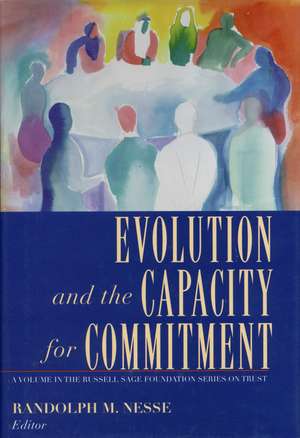Evolution and the Capacity for Commitment: Russell Sage Foundation Series on Trust
Editat de Randolph Nesseen Limba Engleză Hardback – 28 noi 2001
Commitment is at the core of social life. The social fabric is woven from promises and threats that are not always immediately advantageous to the parties involved. Many commitments, such as signing a contract, are fairly straightforward deals, in which both parties agree to give up certain options. Other commitments, such as the promise of life-long love or a threat of murder, are based on more intangible factors such as human emotions. In Evolution and the Capacity for Commitment, distinguished researchers from the fields of economics, psychology, ethology, anthropology, philosophy, medicine, and law offer a rich variety of perspectives on the nature of commitment and question whether the capacity for making, assessing, and keeping commitments has been shaped by natural selection. Game theorists have shown that players who use commitment strategies—by learning to convey subjective offers and to gauge commitments others are willing to make—achieve greater success than those who rationally calculate every move for immediate reward. Evolution and the Capacity for Commitment includes contributions from some of the pioneering students of commitment. Their elegant analyses highlight the critical role of reputation-building, and show the importance of investigating how people can believe that others would carry out promises or threats that go against their own self-interest. Other contributors provide real-world examples of commitment across cultures and suggest the evolutionary origins of the capacity for commitment. Perhaps nowhere is the importance of commitment and reputation more evident than in the institutions of law, medicine, and religion. Essays by professionals in each field explore why many practitioners remain largely ethical in spite of manifest opportunities for client exploitation. Finally, Evolution and the Capacity for Commitment turns to leading animal behavior experts to explore whether non-humans also use commitment strategies, most notably through the transmission of threats or signs of non-aggression. Such examples illustrate how such tendencies in humans may have evolved. Viewed as an adaptive evolutionary strategy, commitment offers enormous potential for explaining complex and irrational emotional behaviors within a biological framework. Evolution and the Capacity for Commitment presents compelling evidence for this view, and offers a potential bridge across the current rift between biology and the social sciences. A Volume in the Russell Sage Foundation Series on Trust
Preț: 213.79 lei
Nou
Puncte Express: 321
Preț estimativ în valută:
40.91€ • 42.71$ • 33.86£
40.91€ • 42.71$ • 33.86£
Carte indisponibilă temporar
Doresc să fiu notificat când acest titlu va fi disponibil:
Se trimite...
Preluare comenzi: 021 569.72.76
Specificații
ISBN-13: 9780871546227
ISBN-10: 0871546221
Pagini: 352
Dimensiuni: 152 x 229 x 33 mm
Greutate: 0.65 kg
Ediția:New.
Editura: Russell Sage Foundation
Colecția Russell Sage Foundation
Seria Russell Sage Foundation Series on Trust
ISBN-10: 0871546221
Pagini: 352
Dimensiuni: 152 x 229 x 33 mm
Greutate: 0.65 kg
Ediția:New.
Editura: Russell Sage Foundation
Colecția Russell Sage Foundation
Seria Russell Sage Foundation Series on Trust
Notă biografică
RANDOLPH NESSE is professor of psychiatry and professor of psychology at the University of Michigan. CONTRIBUTORS: Randolph Nesse, Eldridge S. Adams, Robert Boyd, Dov Cohen, Lee Alan Dugatkin, Robert H. Frank, Herbert Gintis, Oliver R. Goodenough, Jack Hirshleifer, William Irons, Peter J. Richerson, Michael Ruse, Thomas C. Schelling, Joan B. Silk, and Joseph Vandello.
Cuprins
Foreword: Beyond Selfishness in Modeling Human Behavior xiii Herbert Gintis Chapter 1 Natural Selection and the Capacity for Subjective Commitment 1 Randolph M. Nesse PART I CORE IDEAS FROM ECONOMICS 45 Chapter 2 Commitment: Deliberate Versus Involuntary 48 Thomas C. Schelling Chapter 3 Cooperation Through Emotional Commitment 57 Robert H. Frank Chapter 4 Game-Theoretic Interpretations of Commitment 77 Jack Hirshleifer PART II COMMITMENT IN ANIMALS 95 Chapter 5 Threat Displays in Animal Communication: Handicaps, Reputations, and Commitments 99 Eldridge S. Adams Chapter 6 Subjective Commitment in Nonhumans: What Should We Be Looking for, and Where Should We Be Looking? 120 Lee Alan Dugatkin Chapter 7 Grunts, Girneys, and Good Intentions: The Origins of Strategic Commitment in Nonhuman Primates 138 Joan B. Silk PART III COMMITMENT IN HUMANS 159 Chapter 8 Honor and "Faking" Honorability 163 Dov Cohen and Joseph Vandello Chapter 9 The Evolution of Subjective Commitment to Groups: A Tribal Instincts Hypothesis 186 Peter J. Richerson and Robert Boyd Chapter 10 Morality and Commitment 221 Michael Ruse PART IV COMMITMENT IN HUMAN SOCIAL GROUPS 237 Chapter 11 Commitment in the Clinic 240 Randolph M. Nesse Chapter 12 Law and the Biology of Commitment 262 Oliver R. Goodenough Chapter 13 Religion as a Hard-to-Fake Sign of Commitment 292 William Irons Chapter 14 The Future of Commitment 310 Randolph M. Nesse












